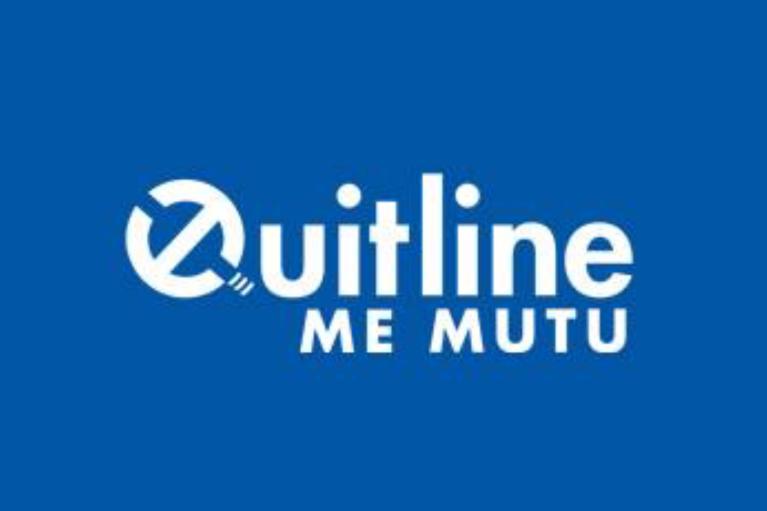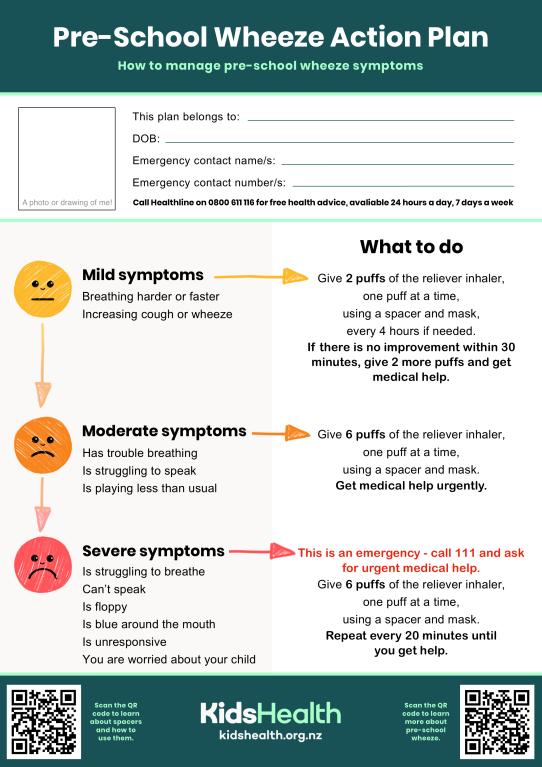Key points about pre-school wheeze
- pre-school wheeze often starts with a cough or a cold
- in most cases, you can care for your child at home
- if your child is having trouble breathing, take them to a health professional
- smoking increases the risk of pre-school wheeze in tamariki (children) - don't smoke in the house or car or anywhere around your child
What is wheeze?
Wheezing is a musical, whistly sound that young tamariki make, usually when breathing out. It can also happen when they breathe in. The sound comes from the chest, not from the nose or throat.
The wheeze often starts with a cough or a cold caused by a virus.
Cough and wheezing are common when young tamariki have colds and chest infections.
Who gets pre-school wheeze
- pre-school wheeze is common - almost 1 in 3 tamariki have it at least once
- tamariki who are around people who smoke are more likely to get pre-school wheeze
- pre-school wheeze is more common in premature pēpi (babies), pēpi who have had bronchiolitis or tamariki who have siblings that wheeze
Why pre-school wheeze happens
A cold may cause a narrowing of the small airways or an increase in mucus production in your child's lungs.
The wheeze may return each time your child has a cold and can last for several days.
Is pre-school wheeze the same as asthma?
Wheezing does not usually mean your child has asthma. It's often difficult to tell whether very young tamariki have asthma, as they have narrower airways and tend to get a lot of colds.
More than half of tamariki with pre-school wheeze will grow out of it as their airways grow and develop. Some tamariki with frequent pre-school wheeze may go on to develop asthma. This is more likely if:
- there are allergic conditions such as asthma, hay fever or eczema in the whānau (family)
- a child has eczema, hay fever or allergies
- a child is growing up around cigarette smoke
Signs and symptoms of pre-school wheeze
Pre-school wheeze often starts as a cold, with a runny nose. Your child might also have:
- fast breathing
- extra noises when breathing in or out or both
- a cough
- a fever
Managing pre-school wheeze
Most tamariki with pre-school wheeze get better by themselves without any treatment.
Antibiotics do not help with pre-school wheeze.
Health professionals may give a reliever inhaler to some tamariki with pre-school wheeze. The same medicine is used for asthma. It's sometimes called a reliever or a puffer. This medicine helps open the airways to allow air to move in and out of the lungs more easily.
How to use a reliever inhaler
You will need to use the reliever inhaler with a plastic tube called a spacer and a mask. Ask your health professional to show you how to use these properly.
If your health professional has given your child a reliever inhaler:
- give 2 puffs of the reliever inhaler, one puff at a time, using the spacer and a mask, every 4 hours
- for each puff of the reliever inhaler, your child will need to take 6 breaths through the spacer and mask
If your child is still not improving:
- you can give up to 6 puffs of the reliever inhaler every 4 hours
Take your child to a health professional urgently:
- if you need to give the reliever inhaler more often than every 4 hours
- if there is no improvement 30 minutes after giving 6 puffs of the reliever inhaler
When to get medical help for pre-school wheeze
When to see a health professional urgently
See a health professional urgently if:
- your child's chest muscles are sucking in when they breathe
- they're using extra neck muscles to breathe
- they can only speak a few words at a time
- they have flaring of the nostrils - the nostrils move out as your child breathes
- they look pale and unwell
- you think they've choked on something
Even if you've already seen a health professional, if your child's breathing difficulties get worse or you are worried, take your child back to a health professional.
When to call 111
Call 111 within New Zealand (use the appropriate emergency number in other countries) and ask for urgent medical help if your child:
- is blue around the mouth
- is struggling to breathe
- is becoming very sleepy and not easy to wake up
- is floppy
Signs That Children Are Struggling To Breathe
Caring for your child with pre-school wheeze at home
Encourage plenty of fluids and let your child eat if they want to.
Tamariki with pre-school wheeze may not be able to drink as much as usual - offer smaller amounts more often.
Give your child as much rest as possible.
Keep your child's environment smoke-free and vape-free.
If your child is miserable and upset, you can give paracetamol - you must follow the dosage instructions on the bottle. It is dangerous to give more than the recommended dose.
Keep your child home from school or daycare until they have recovered.
Hospital care for pre-school wheeze
Help with breathing and getting enough fluids
Tamariki with more serious pre-school wheeze may need to go to hospital. Sometimes tamariki need help with their breathing. This might include extra oxygen through small soft plastic tubes that fit into your child's nose, or a breathing mask.
Other medicines
Your child may need other medicines that they breathe in, or sometimes medicines through an IV line (cannula).
Preventing pre-school wheeze
Smoke-free environment
Keep your child’s environment smoke-free and vape-free. If you want to give up smoking or vaping, contact Quitline or talk with your health professional or whānau.

If you want to give up smoking or vaping call Quitline free on 0800 778 778 or text 4006. Quitline can provide free support and advice to help you or someone in your whānau quit smoking. Visit their website for more information.
A warm house
Keeping the house warm, dry and well-insulated will also decrease your child's risk of developing pre-school wheeze.
Printable pre-school wheeze action plan
Download and print a pre-school wheeze action plan for your child. This talks you through steps to take when your child has pre-school wheeze symptoms. If you're not sure about anything, talk with your health professional.
Fill out the action plan and share it with whānau and your child's childcare centre.

Source: KidsHealth
References
Starship clinical guideline. Chest x-ray in acute wheeze.
The Sydney Children's Hospital Network. Viral induced wheeze.
Australian Family Physician. The wheezing child: An algorithm.
BPAC NZ. Assessing wheeze in pre-school children.
Department of Health. Government of Western Australia. Wheezing in children.
Better Health Channel. Coughing and wheezing in children.
